#The Mole People 1956 Movie
Text


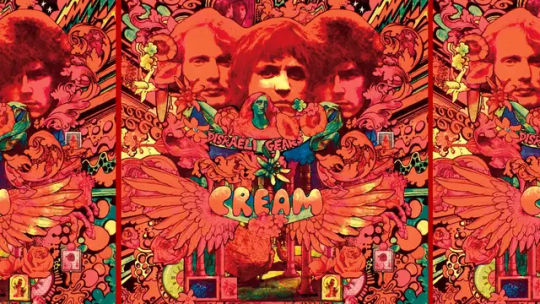


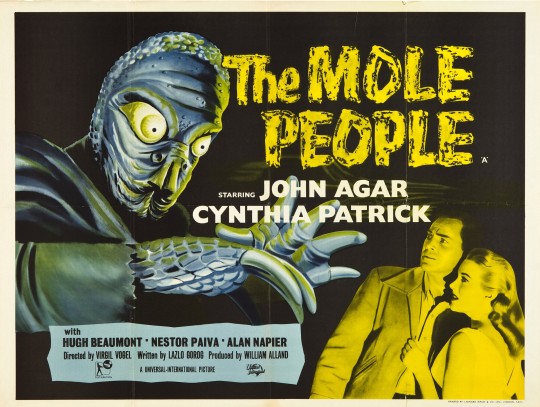

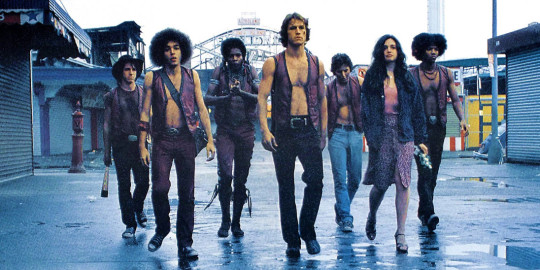
THE ART OF THE COVER PHOTO -- PART 2 OF 2 -- MARCH 2024 EDITION.
PIC(S) INFO: Spotlight on the second handful of cover photos that I've used for my Tumblr blog over the past month, featuring such online finds as:
The late Sakevi Yokoyama (196?-2023), vocalist/lyricist/graphic artist for Japanese hardcore/heavy metal band G.I.S.M., performing in 1984.
The sensually-charged close-up photography of Harry Peccinotti.
The psychedelic sleeve art of British blues band CREAM, created by Martin Sharp for their second album "Disraeili Gears."
The dancing Tiger Woman from the British/Hammer horror film "Vampire Circus" (1972)
A tender photo taken at the former Southwestern High School, Detroit, Michigan, USA, during the class of 1987-'88, later borrowed by Swedish dream pop band, THE RADIO DEPT. 📸: Manny Crisostomo.
Movie poster design for the American sci-fi/horror/adventure film "The Mole People" (1956), distributed by Universal Pictures International.
A 2017 photograph titled "Circling the Small Ads (After Harland Miller)" by Miles Aldridge -- featuring fashion model Cleo Cliwek.
Film still from the American action/thriller film "The Warriors" (1979), directed by Walter Hill, and based on Sol Yurick's 1965 novel of the same name.
Sources: IMDb, Mutual Art, Heritage Auctions, YouTube, Pinterest, Picuki, The Black Box Club, Detroit Free Press, various, etc...
#Tumblr Cover Photos#Cover Photos 2024#Tumblr Cover Photos 2024#Cover Photos#GIZUMU#Japanese hardcore punk#Hair and Makeup#Female beauty#CREAM Disraeli Gears 1967#CREAM band#Disraeli Gears 1967#The Warriors 1979#The Mole People 1956 Movie#THE RADIO DEPT. Bachelor Kisses#Sakevi#Fashion photography#Psychedelic rock#Psychedelic Art#Miles Aldridge#1979#Harry Peccinotti photography#1967#Poster Art#Sakevi Yokoyama#The Mole People#Sci-fi/horror#The Warriors#Vampire Circus#THE RADIO DEPT.#Vampire Circus 1972
1 note
·
View note
Text

The Mole People (1956)
107 notes
·
View notes
Text
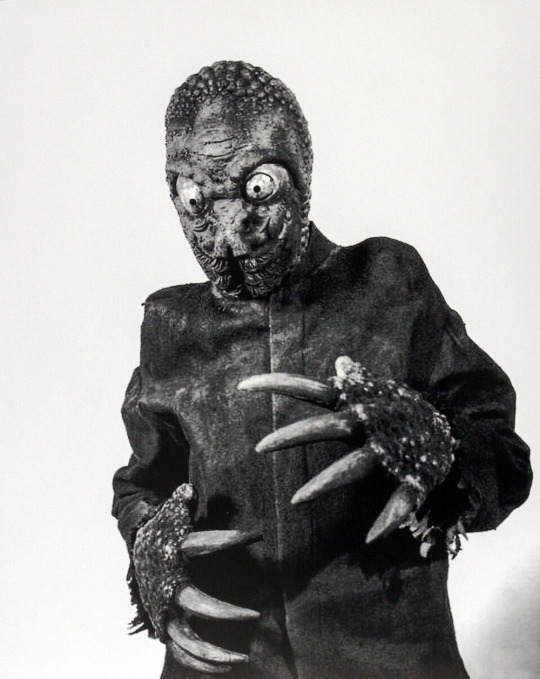
Bob Herron in The Mole People (1956)
156 notes
·
View notes
Text
Reflections on my Universal Horror marathon
It is November 1st, 2023. As anyone can tell after being around me for, I don't know, five minutes, I am a huge horror queen. For my birthday this year, I got a big book on Universal horror, filled with production photos, background, trivia, actor bios, etc. I decided to use this book as a sort of guided reading list, where I would marathon all of the movies discussed in the book and read along. When I was first seriously doing a deep dive into horror in 2018, the classic 30s horror franchises were some of the first that I chose to get into, and so it had been five years or so since I had seen some of my old monster friends. (And many of the movies on this list I had not seen before!) I was excited for this project and decided to start it at 99 days until Halloween; I had found a Sam (1) "Countdown to Halloween" clock that counted from 99 days to 0 days last year, at the Spirit Halloween clearence sale. (2) So, 99 days to do a book's worth of movies—how hard could it be?
(1) from Trick r Treat, 2007
(2) He's currently sitting on my bedside table, at 0 days left!
Turns out, it was rather difficult! I hadn't expected the book to have so many entries in it.
The entire list of films that I did is as follows, broken down by chapter:
Silent Era (5 films): The Hunchback of Notre Dame 1923, The Phantom of the Opera 1925, The Phantom of the Opera 1943, The Cat and the Canary 1927, The Man Who Laughs 1928
Dracula (5 films): Dracula 1931, Drácula 1931, Dracula's Daughter 1936, Son of Dracula 1943, House of Dracula 1945
Frankenstein (4): Frankenstein 1931, Bride of Frankenstein 1935, Son of Frankenstein 1939, Ghost of Frankenstein 1942
The Wolf Man (5): Werewolf of London 1935, The Wolf Man 1941, Frankenstein Meets The Wolf Man 1943, House of Frankenstein 1944, She-Wolf of London 1946
The Mummy (5): The Mummy, The Mummy's Hand, The Mummy's Tomb, The Mummy's Ghost, The Mummy's Curse
The Invisible Man (5): The Invisible Man 1933, The Invisible Man Returns 1940, The Invisible Woman 1941, Invisible Agent 1942, The Invisible Man's Revenge 1944
The Gill Man (3): Creature From the Black Lagoon 1954, Revenge of the Creature 1955, The Creature Walks Among Us 1955
"Universal's Lesser Known Monsters" (3+3+6): Paula the Ape Woman—Captive Wild Woman 1943, Jungle Woman 1944, The Jungle Captive 1945; The Creeper—Pearl of Death 1944, House of Horrors 1946, The Brute Man 1946; The Inner Sanctum Mystery Series—Calling Dr Death 1943, Weird Woman 1944, Dead Man's Eyes 1944, The Frozen Ghost 1944, Strange Confession 1945, Pillow of Death 1945
Non-serial horror (14): The Old Dark House 1932, Murders in the Rue Morgue 1932, The Black Cat 1934, The Raven 1935, Black Friday 1940, Man-Made Monster 1941, Horror Island 1941, Night Monster 1942, The Mad Ghoul 1943, The Strange Door 1951, The Black Castle 1952, Tarantula 1955, The Mole People 1956, Monster on the Campus 1958
That's 68 movies in 99 days by my reckoning. I also only did these on the nights that Mack worked or was dancing, which further tightened the number of days that I had. Good thing they were each about 60 minutes. I could never do this in the modern era where everyone bloats their movies to an absurd degree.
See, I thought it would be something small, with like... 30 movies in 99 days. I didn't expect all of this! Maybe I should have checked how many movies that would be before solidly deciding to do this challenge, eh? And it's not even allll of the Universal horror movies—Lugosi and Karloff did like six "duet" movies like The Raven and The Black Cat, but the book only focused on two and briefly name-dropped the others. By the mid-October, when I was in the final chapter, I was doing two or three movies per night, and it was quite a stressful thing, not knowing how I'd get it all to line up before Mack took his Halloweek vacation!
But I did it. I'm extremely proud that I stuck to it. And also, I will absolutely not do it again! Perhaps in another five years I'll have a craving for the Universal horror movies again, and I'll do my favourite 30 or so, but this insanity will not be repeated, or at least not with this time scale.
Anyway. Here are some things I wish to talk about:
Appreciating Silent Film
The silent era has always been one that I've wanted to get into, but I've never known how exactly to break into it. I've done a few silent movies before—if you're looking for a rec, Häxan from 1923 is a very disturbing and deeply effective look at medieval witchcraft—but I never felt like I had a sure footing in it.
And, well, the book starts at 1923 with Hunchback, no easing into it. And, turns out, it was mostly fine!
The 1925 Phantom was stunning. I love the tinted vibes of the silent era, and this film had a rare Technicolor sequence during the Masquerade bit where all the costumes were in colour, and it was amazing to see. There's a 19...29, I think?, scored version, which is what I watched, and the score pops off.
The 1927 Cat and the Canary ended up as one of my favourites of the whole marathon—there's no scoring option for this, but it's so fun I didn't care. The story revolves around a will reading on a dark and stormy night, a will reading, and a sudden heiress who has to prove her sanity as a condition of the will, all while an antagonistic family and a killer are loose in the mansion. It's a horror-comedy, and it is such a good time. I had rated it 5/5 on letterboxd years ago, but I had forgotten why, and I quickly rediscovered the reason!
So yeah, I got a couple silents to add to my résumé, next to stuff like Häxan and the typical Dr Caligari.
2. The Evolution of What Horror Is
One of my favourite things to think about and consider is what society's horror fixation is in a given era and how it all ties together in a sort of greater historiography.
This marathon covers the 20s through the late 50s, with most of it happening in the 30s and 40s. There's a pretty clear chain of where the focus goes in these—in the 20s, it's a lot of classic adaptations that have a gruesome element but which may not be yknow categorical Genre Horror as we recognise it and label it on a dvd box. The 30s explore the more typical folk myths and superstitions, such as vampires and werewolves; if there is science, it is either rather crude or primitive (Frankenstein using lightning bolts and sewing pieces of body together) or even has a mystical connection (Werewolf of London's Tibetan miracle flower—often this mysticism can unfortunately veer into Orientalist tropes :/). The 40s, and particularly around 1945 with the atomic bomb, the old superstitions lose steam and modern science begins to catch up, to the point that the 50s horror movies are, essentially, all a world away in terms of science—I mean, they try behavioural therapy on the Creature from the Black Lagoon in Revenge of the Creature! The later "Monster Mash" movies where all of the classic monsters join up have them turning to modern science to solve their problems—I believe it's in House of Dracula where the Wolf Man is legitimately ""cured"" by a cranial surgery based on some science, and Dracula gets cured by looking at the particulates in his blood and stuff. Anyway, continuing in the 50s, There's all this talk of atoms and radiation and such, and it's such a strong blend of science fiction and horror, such that the two genres are practically constant bedmates for this era. (Contrary to a popular tumblr post comparing Godzilla to 50s superhero comics, radiation actually did inspire a lot of monsters in America too; you just needed to know where to look, and it's here, in the giant Creature Features, where Godzilla would fit right in.)
I remember shortly after House of Dracula, I was talking to Mack, and I essentially launched into a ten minute lecture about this stuff, how it all ties into what was happening in society and whatnot. I have so much to say, but I won't word vomit it here.
3. These Movies Said, Continuity WHO?
One of the recurrent jokes I had while watching these movies is that the writers were clearly not interested in keeping continuity between films. There are two instances that I internally screamed at because of how insane they were—(1) In House of Frankenstein, Dracula is destroyed in the sunlight, The Wolf Man is shot by a silver bullet and dies, and the Frankenstein creature sinks into quicksand and disappears. Most of the plot of House of Frankenstein is quickly retold by the mad scientist character of House of Dracula; he leaves out the Wolf Man's death, probably because it would upset the Wolf Man, to whom he is speaking. Dracula is also back without explanation. (2) The Mummy's Ghost is set in Connecticut; they are very emphatic that they are in Connecticut. It is said over and over. At the end, the Mummy is chased into the swamp of Connecticut (yknow, the famous swamps of Connecticut) —at the very beginning of The Mummy's Curse, they point to a stretch of swampland, say that THIS is where Kharis sank all those years ago (it was 6 months in real time btw), and that he should still be there. This movie is set in the bayou of Louisiana, with a cheerful barkeep woman singing in French to evoke the whole "Cajun French" world. How Kharis went from Connecticut to "this is the exact spot where he fell" in Louisiana? Never mentioned.
Additionally, in one of the later Frankensteins, Ygor has his brain transplanted into the Frankenstein Monster in a scheme; Ygor-Frankenstein Monster triumphantly turns to the assembled characters and speaks to them, telling them how he tricked them and won. In the next movie, which I believe is Meets The Wolf Man, the Frankenstein Monster is a mute brute once more, and Ygor does not exist anymore. Now, the wildest thing is that this is not the writers cherrypicking what is canon and what is not—no, in the script the Frankenstein Monster-Ygor was to have deep conversations with the Wolf Man, and this was recorded. It was only in post-production that all of this was struck; all those scenes were either tossed or edited down. Apparently there are visuals of those scenes in the movie where you can watch the FM's mouth move, but the audio has been replaced with music or sound effects. Wild stuff.
There's more, plenty more, but you get the picture. I suppose in a world without home video, where your audience may not have seen the previous films or may not remember them well, you can convince them of anything and continuity matters less.
4. Some of these movies destroyed my will to go on (with the marathon)
Overall, I greatly enjoyed my time with this marathon. I found most of these movies to be very interesting and illuminating.
But there are two series in this that just crushed my spirit—The Mummy and Paula the Ape Woman. They were so awful that it made me not want to keep going.
The Mummy is just such a confused mess; the worst time I had was with The Mummy's Tomb. Tomb is the third movie in the series, so of course there's some catch-up that has to be done to get the audience up to speed. (They all do it, it's normal.) Now, this is a 60 minute movie. Tomb begins with a TWELVE MINUTE "recap" of the first two movies, using a flashback to show scenes from the old movies—all the while narrating them to construct a new story of what supposedly happened and wildly making up new stuff that directly contradicts what is visible on screen. TWELVE MINUTES out of SIXTY, one fifth of the movie, is just incredibly out of context scenes to do whatever the writers want.
And that's not even getting into the cultural sensitivity discussions around these movies, because girl........... girl. It's rough on that front, to say the least. (They reuse an Incan temple, if I remember right, as an Egyptian tomb in the last one, I think it was, and you can clearly see Mesoamerican imagery all over the walls, but they're yelling about pharoahs and stuff. And that's the tip of the iceberg.)
Paula the Ape Woman is about an ape who gets a brain and blood transplant and becomes a real woman, or at least temporarily. Now, audience, given that this an early 40s movie... do you think this uncontrollable, animalistic beast of a woman is going to be white or no? :////
The Paula movies just need to be forgotten. Not every Universal horror movie is a lost gem in the sands of time. Let's just say that.
5. James Whale, Lon Chaney Jr, and thoughts on recurring names and faces
With the studio system firmly in place for most of this marathon's concerned eras, there are many repeating names throughout the movies. It became something of a scavenger hunt to find "Gowns by Vera West" in the title credits of most movies—according to letterboxd, I think I hit 37 movies with her credited on wardrobe.
Some of these repeating names I grew to really like. James Whale really is among the greats, isn't he? Bride of Frankenstein is nothing short of a masterpiece, and his other work (especially The Old Dark House) is great. I would love to do a deeper dive just into his other works. He seems so fascinating! And he was gay, and apparently very very open about it.
A name I came to dislike, unexpectedly really, was Lon Chaney Jr, most known for The Wolf Man. I went in with a higher opinion of him, only knowing him from The Wolf Man; he eventually became a bit of a golden boy on the Universal horror sets, and so he got into a ton of different projects. And boy, did he ever only play one character across everything! He's extremely good at it, but he only ever played a sad, pathetic little man who is overwhelmed by the weight of the world! We get it, dude. Play a different character!
6. Conclusions
This is getting away from me, so I'll wrap this up. Thank you if you even skimmed this far!
I really did enjoy this marathon. It was stressful, a little, but a fun stress, all things considered.
Rapidshot overall favs: The Bride of Frankenstein, the Cat and the Canary, Revenge of the Creature, Dracula, The Old Dark House, Tarantula, 1925's Phantom of the Opera, the Raven.
Rapid boots: The Mummy franchise, Paula the Ape Woman series, She-Wolf of London, the Black Cat, Ghost of Frankenstein.
I love this era of horror: It's almost a cosy horror to me, with giant fog machines, goofy big analog science contraptions, and painted backdrops (you can see the painted backdrops and their flatness during the early 30s ones especially). I like that there are fewer cuts compared to the modern day: They hold the camera on the actors, and often the camera is not on a close-up, giving plenty of time for interesting physicality. It almost feels staged or traditionally theatrical in a way that modern movies do not. (Which makes sense, as the earlier writers and directors and actors all came from and routinely did theatre. Lugosi got Dracula after he did the stage version of it.) Many of them are very comfortable feeling, and they're short too!
I don't think I could do another grand tour like this again for years, at mininum,—and I won't revisit Paula and probably not The Mummy—but I do want to revisit it more than I have in the last few years. These monsters are my FRIENDS!
Anyway. Stan Boris Karloff, James Whale, and especially Elsa Lanchester
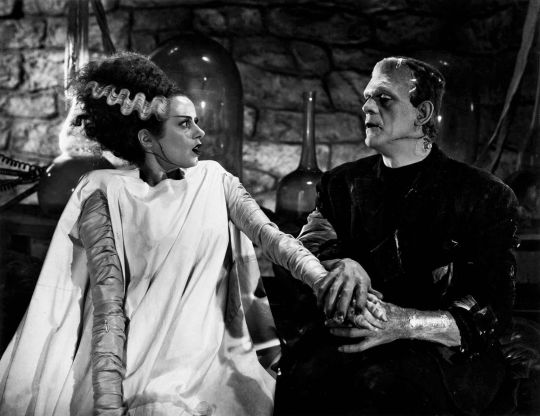
#my universal horror marathon#thank you to anyone who reads#i mostly just wanted to write this up for me
6 notes
·
View notes
Text
UNIVERSAL PURSUING A REVAMP OF 'THE MOLE PEOPLE', ROBERT KIRKMAN PRODUCING
Universal Studios is digging deep into their vault of classic movie monsters for this one.
As Deadline is reporting, the studio has acquired a pitch for a contemporary reimagining of the 1956 creature feature The Mole People. Chris Winterbauer, who sold the pitch to Universal, is also set to pen the screenplay.
In the new take, a woman travels to a town veiled in a conspiracy to rescue her…

View On WordPress
0 notes
Text

The Mole People – Universal Remaking the Classic 1956 Monster Movie
Universal Pictures continues to tap into its classic monsters vault. The studio has acquired a pitch for a revamp of 1956 horror film The Mole People pitched by Chris Winterbauer, who’ll write the script.
In the new take, a woman travels to a town veiled in a conspiracy to rescue her grandchildren from their father. To do this, she must fight through hell in the underground tunnels where the Mole People reside. In the 1956 original, archaeologists stumble into the underground lair of a race of darkness-dwellers who can see in low light and have no pigmentation after being out of the light for so long. The high priest who rules the small pocket of mole people is threatened by the newcomers and wants them dead.
The pic will be produced by The Walking Dead creator Robert Kirkman and Dave Alpert at Skybound. Universal execs Holly Goline, Jay Polidoro and Matt Reilly are overseeing for the studio.
WME reps Winterbauer.
youtube
0 notes
Text
The Mole People (1956) - 1.5 stars
Wow... very bad. While it was an enjoyable B-movie for the first half hour or so, once they get to the underground kingdom is becomes a slog. There's no discernible personalities between the leads and the love interest has a bad case of Born Sexy Yesterday (and is inexplicably blonde and not albino like everyone else in the kingdom - although she's still white, naturally). Ended the movie feeling a little mad about several different aspects of it. Bumping up its rating for the mole people costumes and the surprisingly impressive set pieces and scenery. Also the scene in which they carry out the burned women was surprisingly effective.
0 notes
Text
Ten novel
THE SYMPATHIZER BY VIET THANG NGUYEN
this debut novel could fit into half a dozen genres of Vietnam war books from war narrative to immigrant story, from mystery to political, from metafiction to historical and even dark comedy. The story follows an anonymous North Vietnamese narrator who’s acting as a mole in the South Vietnamese army and is sent to an exile community in the U.S., where he stays embedded in the South Vietnamese community. (bookriot.com)
YEAR OF THE JUNGLE BY SUZANNE COLLINS
The Hunger Games trio, has written one of the most affecting Vietnam war books. Perhaps more of a memoir than straight fiction—thought not fully on either side—the story is that of Young Suzy, whose father goes away to the Vietnam War. (bookriot.com)
CRACKER! THE BEST DOG IN VIETNAM BY CYNTHIA KADOHATA
An excellent example of the reality that not all Vietnam war books must be depressing, this uplifting story follows an army canine unit dog that goes by the name of Cracker. He spends his days with his handler Rick, looking for booby traps; the story is told from first Cracker’s and then Rick’s viewpoints. (bookriot.com)
DOG SOLDIERS BY ROBERT STONE
Dog Soldiers is a story of the Vietnam War and of drug smuggling. Often compared to Joseph Conrad and Ernest Hemingway, and largely considered one of the best Vietnam novels, Stone focuses on two characters, one of whom is a sailor traveling home from Vietnam.(bookriot.com)
THE SHORT-TIMERS BY GUSTAV HASFORD
The Short-Timers, a book that’s currently out of print, but you may have heard of the movie based on it: Stanley Kubrick’s Full Metal Jacket. Hasford wrote this semi-autobiographical novel about his experiences in Vietnam and intended it to be a trilogy of Vietnam war books. (bookriot.com)
DIRTY WORK BY LARRY BROWN
This piece of short fiction is written almost entirely in dialogues and monologues between two critically wounded Marines in Vietnam. The author did serve in the Marines, though not in Vietnam, and tells a convincing tale of the conversation between the men at a veteran’s hospital. (bookriot.com)
CLOSE QUARTERS BY LARRY HEINEMANN
One of the first fictional Vietnam war books, and often touted as one of the best Vietnam novels, it’s a face-paced wonder that follows draftee Philip Dosier as he is drafted into the war, completes a of tour of duty, and comes home. (bookriot.com)
THE SORROW OF WAR BY BAO NINH
This fictional account of Kien, an infantryman for North Vietnam, follows his transformation into a writer, his struggles to overcome his memories of combat, and the terrible mess his life has become as a result. (bookriot.com)
LISTEN, SLOWLY BY THANHHA ALI
Beautiful, lyrical, and impactful, this novel follows Mai, a girl raised in California who can’t understand why she’s being sent off to spend her summer with her grandmother in Vietnam. Upon her arrival, Mai is disappointed in the lack of WiFi, can’t handle the heat, and is put off by the crowds. (bookriot.com)
THE QUIET AMERICAN BY GRAHAM GREENE
The New York Times in 1956 claimed that Greene’s novel about Vietnam had characters that stood in for nations and political factions rather than as their own people. Greene’s conclusion seems to be that America was a somewhat “innocent” nation that did not understand the people it was fighting with or against. (bookriot.com)
0 notes
Text

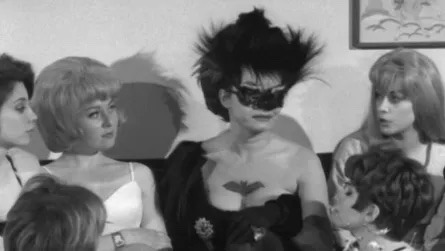
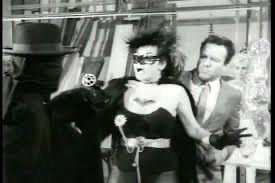

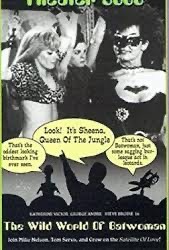

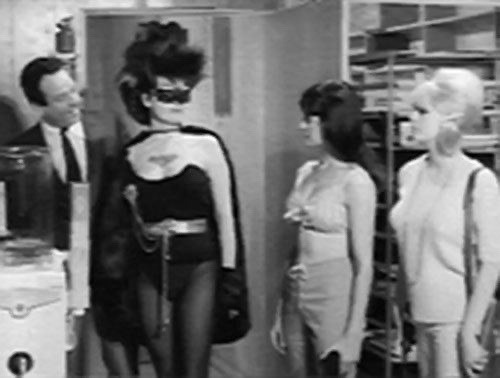
So to cash in on Batman the tv show, director Jerry Warren made this very campy and silly Batwoman . No relation to DC comics or Batman . A very cheap production with Warren regular Katherine Victor in the title role as the bargain basement super hero and her swinging bikini clad super agents. Made in 1966 with a limited budget. The monsters that the loony scientist keeps talking about is footage from the mole people 1956. Surprised they didn’t get sued .Steve Brodie stars as one of the villains. As you recall Jerry Warren made some really bad movies and even bought movies from other countries and added some footage like invasion of the animal people. 1959 which was made in Sweden under the title terror in the midnight sun and the Mexican made werewolf movie with Lon Chaney Jr. face of the screaming werewolf in 1964 which is only 60 min long. Warren also made the very bad Frankenstein’s island 1981 which I covered previously. But as for batwoman ripping off TVs Batman and spy movies. How low can you go?
0 notes
Text

FROM THE VERY DEPTHS OF -- THE MOLE MUTANTS ROSE TO INVADE DOWN UNDER!
PIC INFO: Resolution at 1270x2866 -- Spotlight on an Australian daybill for the American action/sci-fi/horror film "The Mole People" (Universal International, 1956). Directed by Virgil W. Vogel. Artist:
Source: https://movieposters.ha.com/itm/movie-posters/a/161213-50314.s.
#The Mole People 1956#The Mole People#The Mole People 1956 Movie#50s Sci-fi#50s Movies#B-Movies#1950s#1956#Movie Poster#Movie Posters#Posters#Poster#Poster Design#Graphic Design#Monster Movies#Horror#Poster Art#Universal International#American Style#Mutants#Americana#Vintage Sci-fi#Vintage Science Fiction#Hollow Earth#Mole People#Virgil Vogel#Sci-fi Horror#Sci-fi Fri#Mutant Mole Men#Sci-fi
0 notes
Text
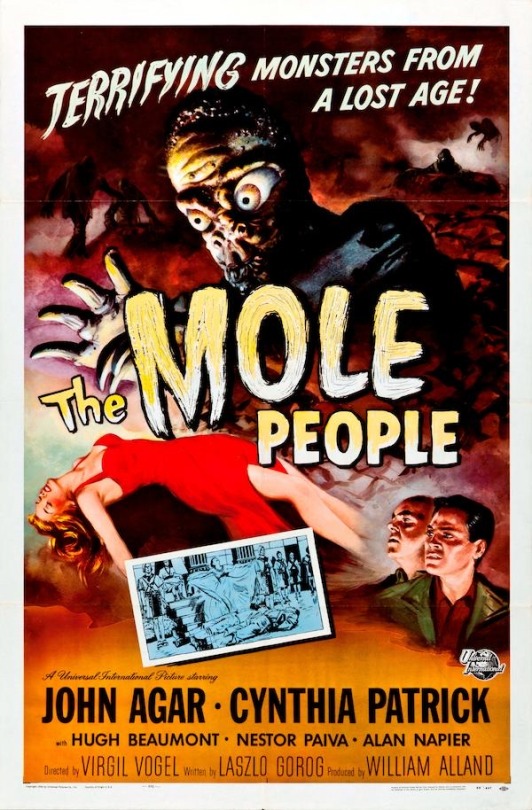
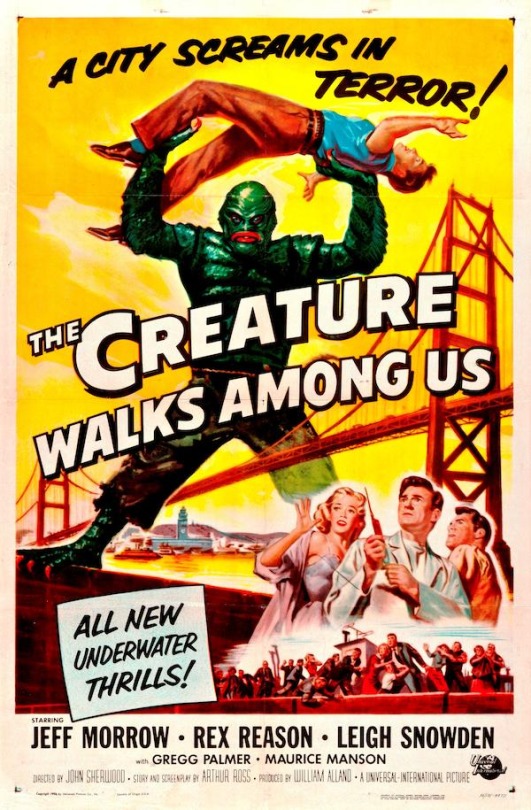
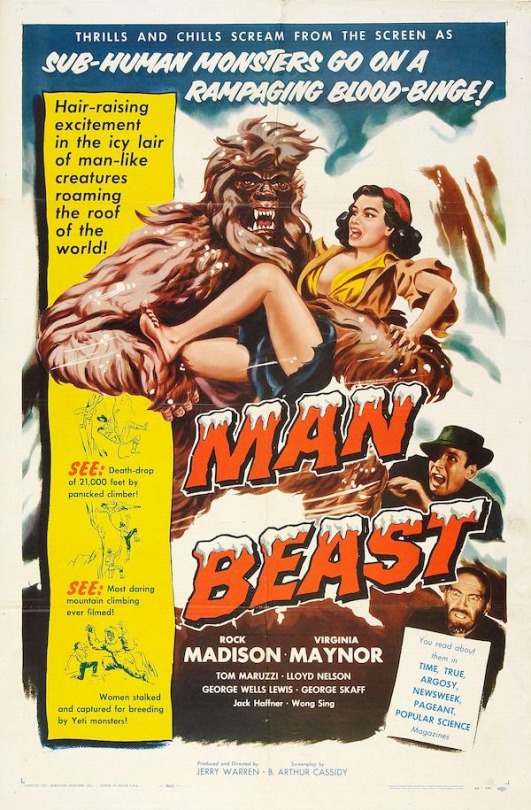
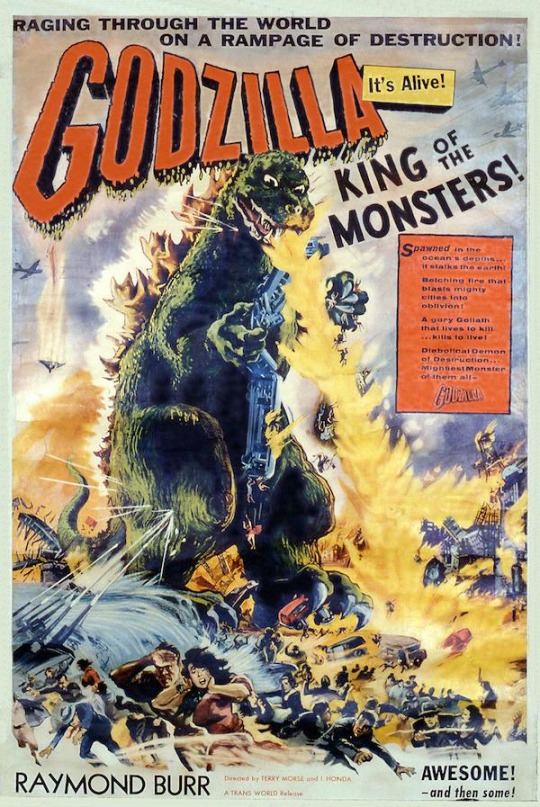
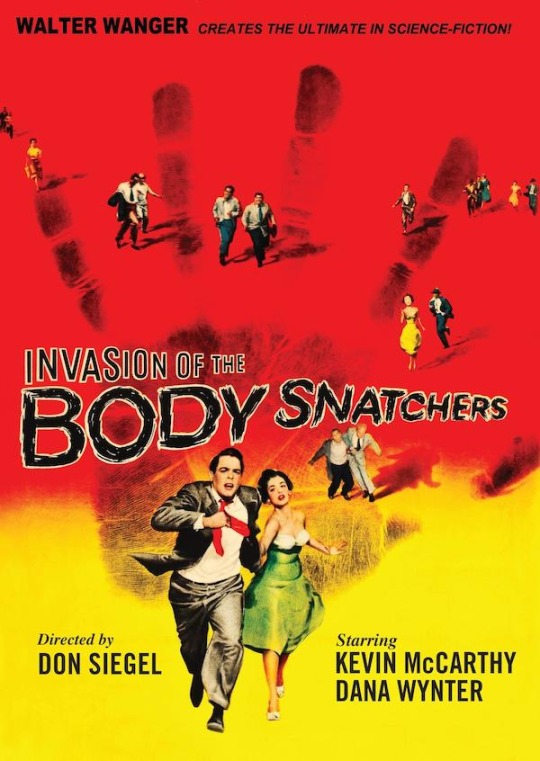

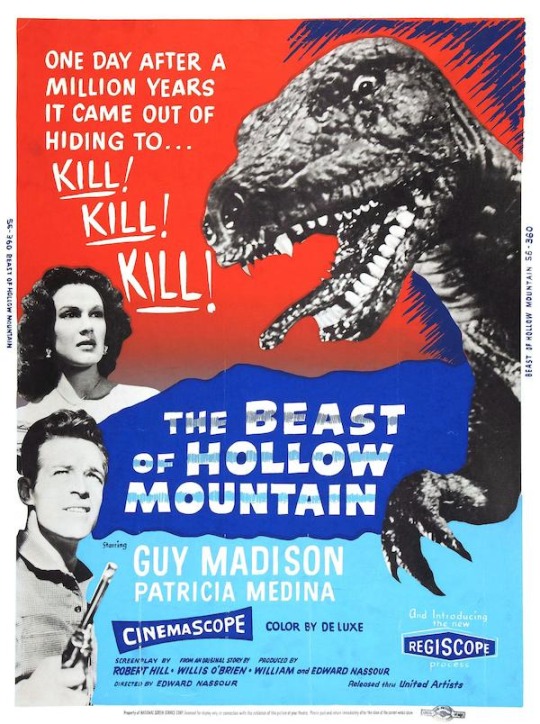
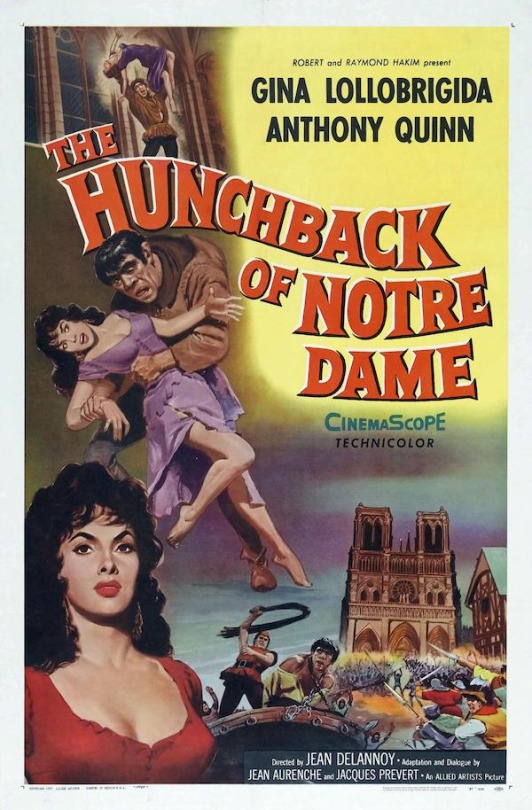
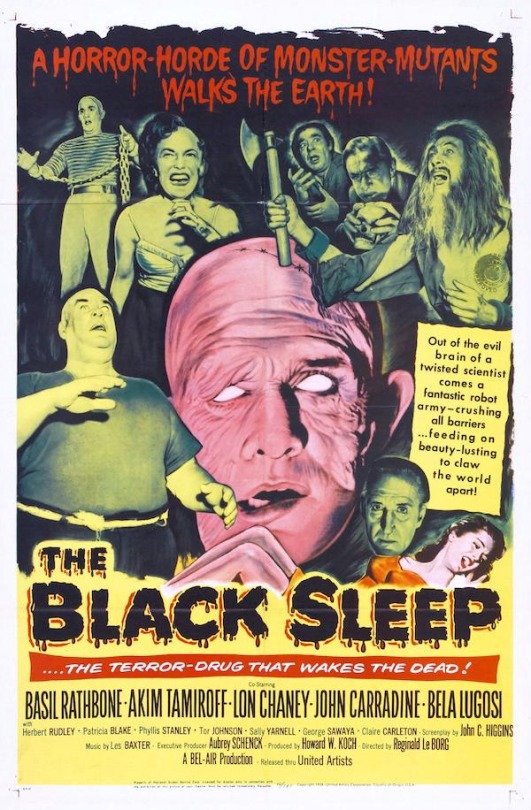
Horror movies that came out in 1956
#horror#horror movie#horror movies#movie#movie posters#posters#movie poster#poster#1956#50s movie#50s horror movie#50s horror#50s movies#50s films#50s#Godzilla#godzilla king of the monsters#the mole people#the creature walks among us#invasion of the body snatchers#the bad seed
103 notes
·
View notes
Text

The Mole People (1956)
105 notes
·
View notes
Text
The Mole People - USA, 1956
The Mole People – USA, 1956
‘Terrifying… monsters from a lost age!’
The Mole People is a 1956 American science fiction horror feature film directed by Virgil W. Vogel (The Land Unknown) from a screenplay by László Görög (The Spider). It was produced by William Alland (This Island Earth; Tarantula; Creature from the Black Lagoon). The Universal-International movie stars John Agar, Cynthia Patrick, Hugh Beaumont, Nestor…
View On WordPress
#1956#Cynthia Patrick#film#horror#Hugh Beaumont#John Agar#movie#review#reviews#The Mole People#Universal#Virgil W. Vogel
1 note
·
View note
Photo

Recently watched: The Wild World of Batwoman (1966). Tagline: “A Thrill-cade of Excitement! Roaring through the city streets into Wildville!”
Look, I have a high (possibly masochistic) tolerance for terrible films. In fact, I have a twisted affection for them. Give me a The Brain That Wouldn’t Die (1962) or I Eat Your Skin (1971), and I’m transfixed. But The Wild World of Batwoman defeated even me. Its duration is a mere one hour and six minutes, and yet somehow it felt like three numbing hours long. IMDb gives up on even attempting a synopsis: “The pointlessly named Batwoman and her bevy of Batmaidens fight evil and dance.” (Rotten Tomatoes makes more of an effort: “A busty vampire needs a scientist's atomic bomb, made from a hearing aid, to save a comrade”). Opportunistic hack director Jerry Warren clearly aimed to exploit the popularity of the campy Batman TV series. When they legally threatened him over copyright infringement, Warren simply re-titled it She Was a Hippy Vampire.
Anyway, the titular Batwoman (ineptly played by Katherine Victor) is a tired looking middle-aged woman in an exploding punk fright wig, Halloween mask and dominatrix outfit. She’s also a crime-fighting vampire ruling over a bevy of groovy “Bat Chicks” who are forever breaking into frantic go-go dancing. (Are they doing the Frug? The Watusi? The Jerk? I couldn’t tell you). The ensuing wacky hijinks are utterly incomprehensible. To add to the confusion, Warren also pads-out the action by splicing in footage from The Mole People (1956), an entirely different film. The naïve kitschy tone has its appeal. There’s some decent twang-y garage rock music. The Wild World of Batwoman would inevitably be more tolerable broken into chunks on something like Elvira’s Movie Macabre or Mystery Science Theatre 3000. Anyway, I stuck it out to the bitter end. I defy you to the do the same! The Wild World of Batwoman is routinely described as one of the worst films ever made – find out why! Watch on YouTube.
#the wild world of batwoman#jerry warren#bad movies we love#bad movies for bad people#b-movie#lobotomy room#shock value#bad taste
19 notes
·
View notes
Photo

The Mole People (1956)
#the mole people gif#monster gif#50s sci fi gif#the mole people#50s sci-fi movies#50s sci-fi#50s movies#cynthia patrick#sci-fi#1950s#1956#gif#chronoscaph gif
336 notes
·
View notes
Text
Today is a very special day, it’s Marilyn’s Birthday! Can you believe that if she were still alive, Marilyn would have been turning 94 years old today – just two months younger than the Queen herself! With each year I always try and write a special post about this amazing woman, who has helped me so much and achieved more than anyone could have imagined in her 36 years. Therefore, I decided to write 94 facts about the Birthday Girl – some you may know, some you may not, all in the hope that genuine things will be learnt and the real Marilyn will be more understood and appreciated.
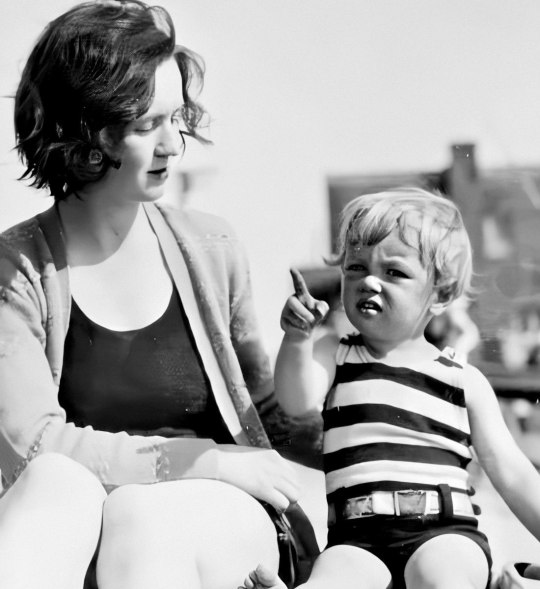
Gladys and baby Norma Jeane spend some quality time together on the beach in 1929.
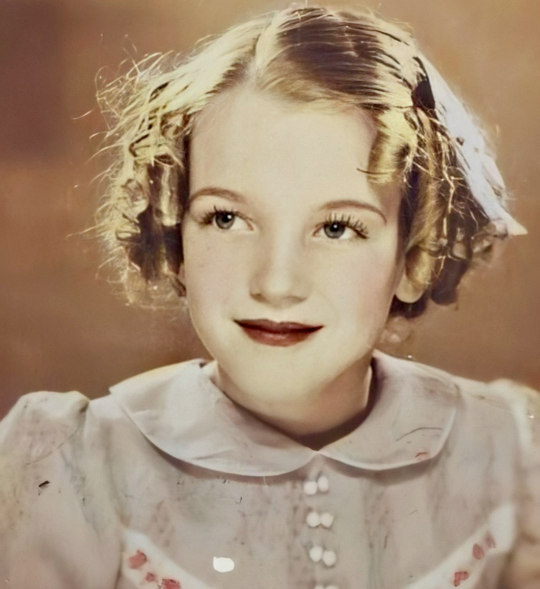
Little Norma Jeane, aged seven, in 1933.

Norma Jeane photographed by David Conover whilst working at the Radio Plane Munitions Factory in either the Fall of 1944 or Spring of 1945.
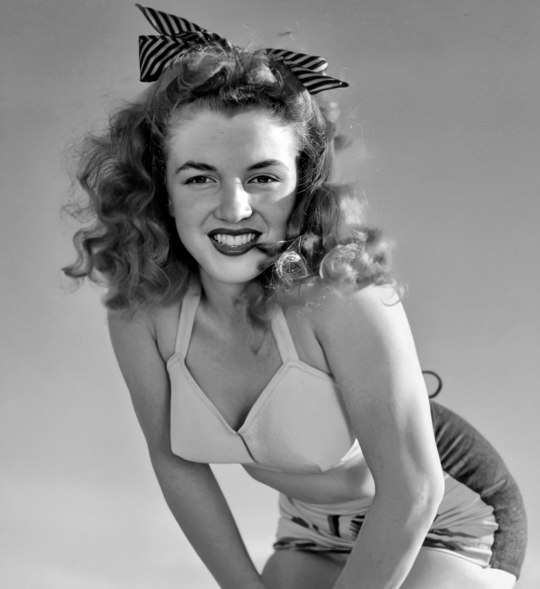
Norma Jeane by Andre de Dienes in late 1945.
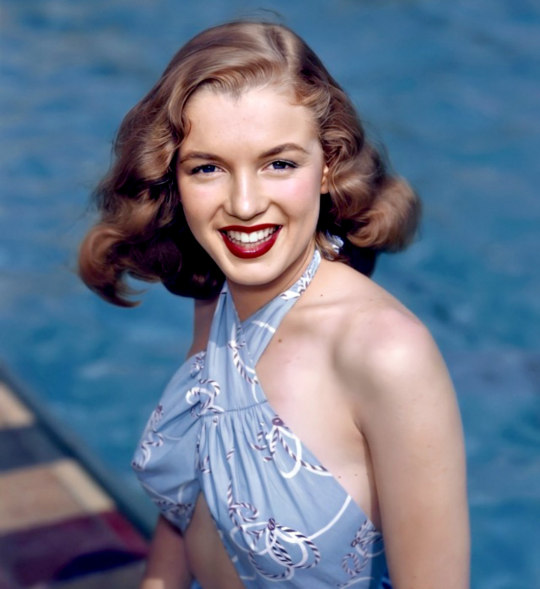
Marilyn by Richard Miller in 1946.
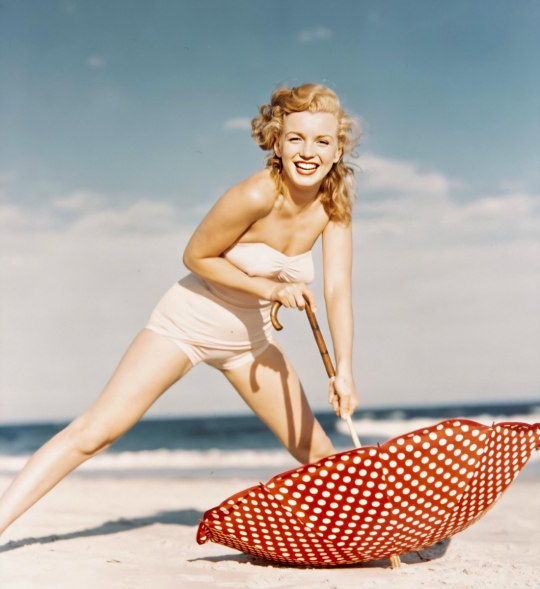
Marilyn on Tobey Beach by Andre de Dienes on July 23rd 1949.
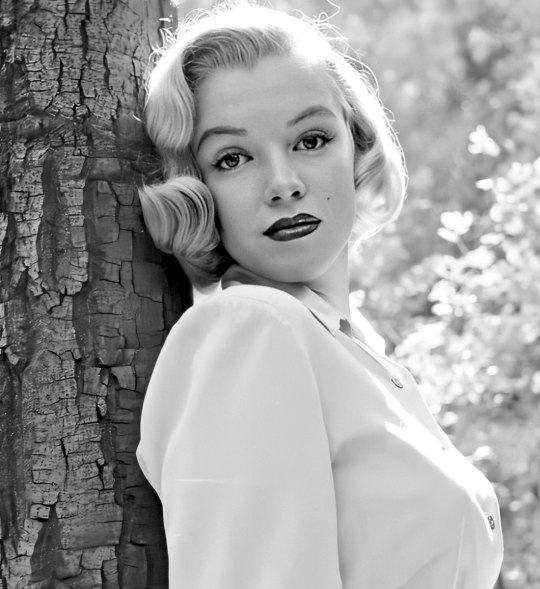
Marilyn by Ed Clark in Griffith Park in August 1950.
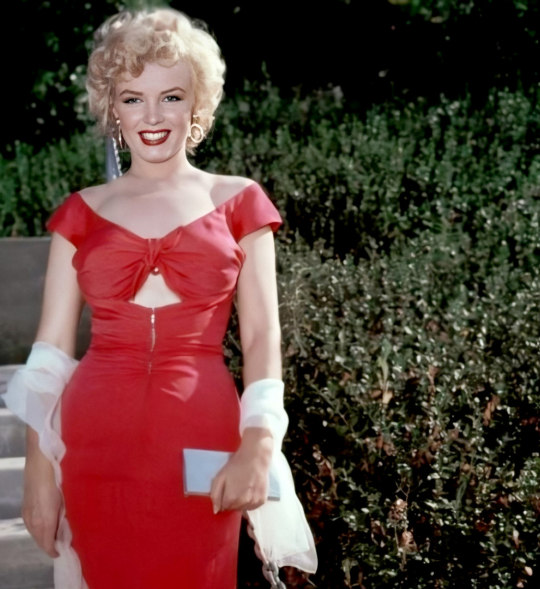
Marilyn attends a Party in Ray Anthony’s home, organized by 20th Century Fox on August 3rd 1952.

Marilyn filming The Seven Year Itch on location in New York City by Sam Shaw on September 13th 1954.
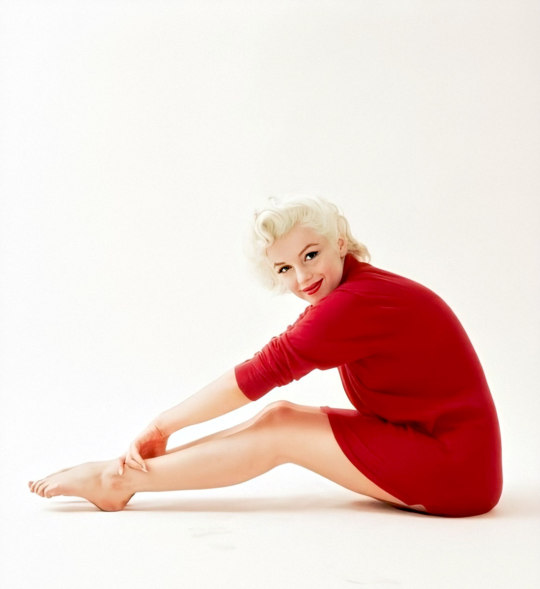
Marilyn by Milton Greene on January 28th 1955.
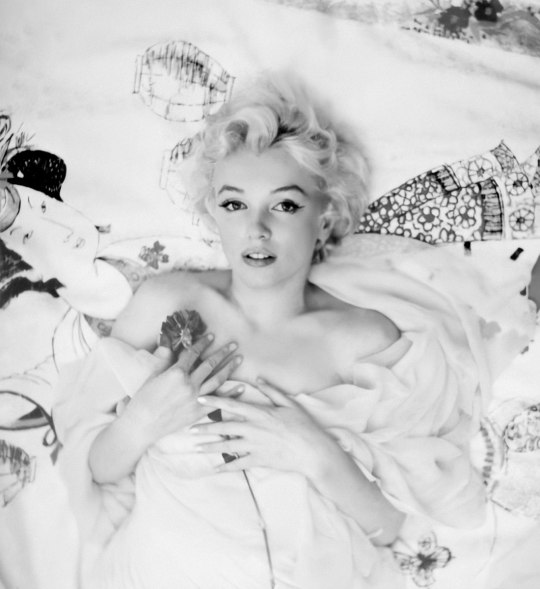
Marilyn by Cecil Beaton on February 22nd 1956. This was her favourite photo of herself.
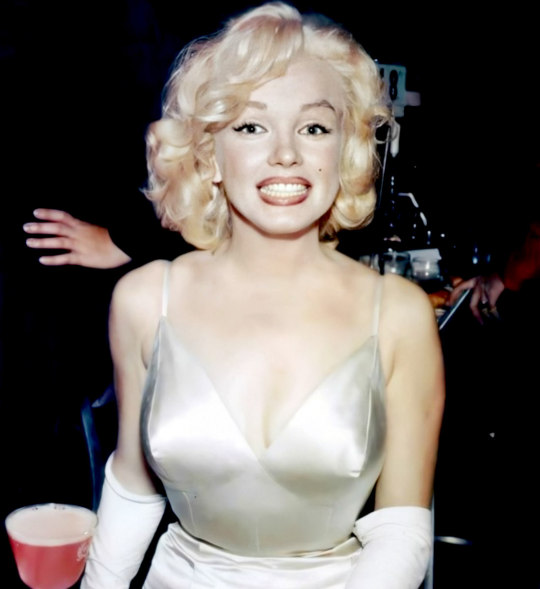
Marilyn attending the Premiere of The Prince In The Showgirl at the Radio City Music Hall on June 13th 1957.
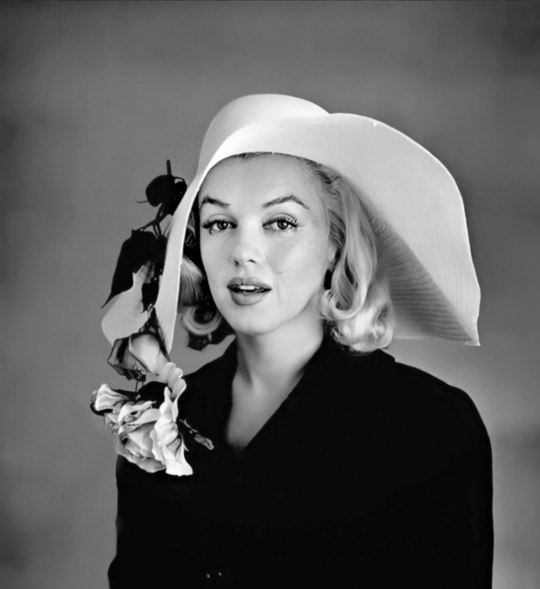
Marilyn by Carl Perutz on June 16th 1958.
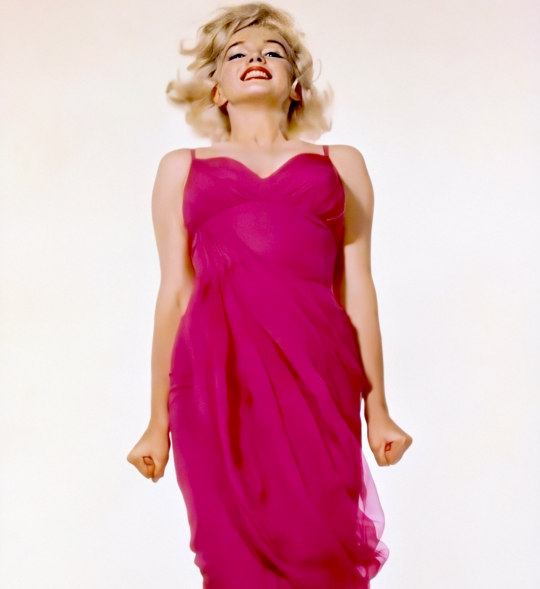
Marilyn by Philippe Halsman for LIFE Magazine in October 1959.

Marilyn attends a Benefit for The Actors Studio at the Roseland Dance City on March 13th 1961.

Marilyn on Santa Monica Beach for Cosmopolitan Magazine by George Barris on July 1st 1962.
______________________________________________________________________________
1. Stood at a height of 5’5½”
2. Born in the charity ward of the Los Angeles County Hospital at 9:30 AM on June 1st 1926.
3. Married three times;
– Jim Dougherty: (June 19th 1942 – September 13th 1946)
– Joe Dimaggio: (January 14th 1954 – 31st October 1955) (Temporary divorce granted on October 27th 1954)
– Arthur Miller: (June 29th 1956 – January 20th 1961).
4. Suffered two confirmed miscarriages; an ectopic pregnancy on August 1st 1957 and miscarriage in December 16th 1958.
5. Suffered with endometriosis very badly, so much so that she had a clause in her contract which stated she would be unable to work whilst menstruating.
6. Starred in 30 films – her last being uncompleted.
7. Favourite of her own performances was as Angela Phinlay in The Asphalt Jungle (1950)
8. Winner of three Golden Globes; two for World Film Favourite – Female in 1954 and 1962 and one for Best Actress in a Motion Picture – Comedy or Musical for her performance as Sugar Kane in Some Like It Hot (1959) in 1960.
9. Her idol was the first Platinum Blonde Bombshell, Jean Harlow.
10. Amassed a collection of over 400 books in her library, ranging from Russian Literature to Psychology.
11. Favourite perfume was Chanel No.5
12. Had two half siblings; Robert “Jackie” Baker (1918 – 1933) and Bernice Miracle (1919) – the former she would never have the chance to meet and Bernice was not informed about Marilyn until she was 19 years old.
13. Former Actor and 20th Century Fox Studio Executive, Ben Lyon created the name Marilyn Monroe in December 1946 – Marilyn after fellow Actress, Marilyn Miller and Monroe after Marilyn’s mother’s maiden name. Ironically enough, Ben starred with Jean Harlow, in her breakout movie, Hell’s Angels (1930).
14. Legally changed her name to Marilyn Monroe ten years later, on February 23rd 1956.
15. Attended The Actors Studio.
16. Third woman to start her own Film Production Company – the first being Lois Weber in 1917 and the second being Mary Pickford in 1919.
17. First had her hair bleached in January 1946 at the Frank & Joseph Salon by Beautician Sylvia Barnhart, originally intended for a Shampoo Advert.
18. Contrary to popular belief, she was technically a natural blonde, not a redhead or brunette. She was born with platinum hair and was very fair until just before her teen years. Her sister described her with having dark blonde hair upon their first meeting in 1944.
19. Another myth debunked – she had blue eyes, not brown.
20. Was one of the few women in the 1950s to use weights when exercising.
21. Wore jeans before it was considered acceptable for women.
22. Her famous mole was real – albeit skin coloured, so she emphasized it using a brown eye pencil.
23. Was a Step-Mother in two of her three marriages to three children – Joe Dimaggio Jr. and Bobby and Jane Miller.
24. Found out she landed the lead role in Gentlemen Prefer Blondes (1953) on her 26th Birthday.
25. Another huge myth dispelled – only actually met President Kennedy four times from 1961 – 1962. Three of them were at public events, with the last being her performance at Madison Square Garden. One of them was at Bing Crosby’s Palm Spring house with various people, so at most (which again, is very unlikely) they had a one night stand – nothing more and nothing less.
26. Was the first Playboy Cover Girl, although she did not actually pose for them, nor give permission for them to be used. Hugh Hefner bought the photograph from a Chicago Calendar Company for $500 and the two never met.
27. Speaking of Playboy, the photo was taken by Photographer Tom Kelley on May 27th 1951 and Marilyn made a total of $50 for the photo shoot. The most famous photo then went on to cause a national sensation after being sold to the Calendar Baumgarth Company and became known as, “Golden Dreams“.
28. In 1955 it was estimated that over four million copies of the Calendar had been sold.
29. Favourite singers were Frank Sinatra and Ella Fitzgerald.
30. Attended the Academy Awards Ceremony only once on March 29th 1951 and presented the award for “Best Sound Recording” to Thomas Moulton for All About Eve (1951) which she also starred in.
31. Performed ten shows over four days to over 100,000 soldiers and marines in Korea in February 1954 – she actually ended up catching pneumonia because it was so cold.
32. Was one of the few Stars who had Director Approval in their Contracts. Some of the names included were, John Huston, Elia Kazan, Alfred Hitchcock, George Stevens, William Wyler, Joshua Logan and Sir Carol Reed.
33. Was pregnant during the filming of Some Like It Hot (1959) – filming finished on November 7th 1958 and she miscarried the following month on December 16th.
34. Featured on the cover of LIFE Magazine seven times during her lifetime;
– April 7th 1952
– May 25th 1953
– July 8th 1957 (International Edition)
– April 20th 1959
– November 9th 1959
– August 15th 1960
– June 22nd 1962
35. Favourite bevarage was Dom Perignon 1953 Champagne.
36. By the time of her death, her films had grossed over $200 million, when adjusted for inflation that is the equivalent of $2 billion in 2019.
37. Designer, William Travilla dressed Marilyn for seven of her films, two (*) of them received Oscar Nominations in, “Best Costume/Design, Color“;
– Monkey Business (1952)
– Gentlemen Prefer Blondes (1953)
– How To Marry A Millionaire (1953) *
– River Of No Return (1954)
– There’s No Business Like Show Business (1954) *
– The Seven Year Itch (1955)
– Bus Stop (1956)
38. Spent 21 months of her childhood at the Los Angeles Orphanage, from September 13th 1935 until June 7th 1937.
39. Was one of the first Stars to speak out about child abuse, with her story appearing in movie magazines as early as 1954.
40. Fostered by her grandmother’s neighbours, Ida and Albert Bolender, for the first seven years of her life.
41. Lived in England for four months, during the period of filming for The Prince and The Showgirl (1957) from July 14th 1956 – November 20th 1956.
42. Her Production Company, Marilyn Monroe Productions produced only one film, The Prince and The Showgirl (1957) based on Terrance Rattigan’s play, The Sleeping Prince.
43. Was photographed by Earl Theisen in October 1952 wearing a potato sack dress after being criticized by the press for her outfit choice at The Henrietta Awards in January 1952. A journalist wrote that Marilyn was “insignificant and vulgar“and “even in a potato bag, it would have been more elegant.“
44. Was a huge supporter of LGBT+ rights, saying the following quote about fellow actor and friend, Montgomery Clift to journalist W.J. Weatherby in 1960,
“I was remembering Monty Clift. People who aren’t fit to open the door for him sneer at his homosexuality. What do they know about it? Labels–people love putting labels on each other. Then they feel safe. People tried to make me into a lesbian. I laughed. No sex is wrong if there’s love in it.”
45. Her measurements were listed as the following by her Dressmakers; 35-22-35 and 36-24-24 by The Blue Book Modelling Agency. For the majority of her life she weighed between 117-120 pounds, with her weight fluctuating around 15 pounds, during and after her pregnancies (1957-1960), although her waist never ventured past 28.5 inches and her dress size today would be a UK Size 6-8 and a US Size 2-4 as she was a vintage Size 12.
46. Her famous white halter dress from The Seven Year Itch (1955) sold for $4.6 million ($5.6 million including auction fees) on June 18th 2011, which was owned by Debbie Reynolds. The “Happy Birthday Mr. President Dress” originally held the record for the most expensive dress, when it was sold on October 27th 1999 for $1.26 million. It then went on to be resold for $4.8 million on November 17th 2016, thus regaining it’s original achievement.
47. Was discovered by Photographer, David Conover, whilst working in The Radio Plane Munitions Factory in the Fall of 1944 or Spring of 1945, depending on sources.
48. Now known as the, “Me Too” movement, Marilyn was one of the first Stars to speak out on the, “Hollywood Wolves” in a 1953 article for Motion Picture Magazine entitled, “Wolves I Have Known”. The most famous incident being with the Head of Columbia Studios, Harry Cohn, who requested Marilyn join him on his yacht for a weekend away in Catalina Island. Marilyn asked if his wife would be joining them, which, as you can imagine – did not go down well and her contract was not renewed with the Studio. Marilyn made only one film with Columbia during her six month contract, this being Ladies Of The Chorus (1948) which was shot in just ten days!
49. Loved animals dearly and adopted a variety of pets over the years. These included a basset hound called Hugo and parakeets, Clyde, Bobo and Butch with Husband Arthur Miller. A number of cats including a persian breed called Mitsou in 1955 and Sugar Finney in 1959. Her most famous pet was gifted to her in March or April of 1961 by friend, Frank Sinatra, a little white maltese named Maf. His full name was Mafia Honey, as a humorous reference to Sinatra’s alleged connections to the Mob. After Marilyn’s death, Maf went to live with Frank Sinatra’s secretary, Gloria Lovell.
50. The book she was reading at the time of her death was Harper Lee’s, To Kill A Mocking Bird.
51. One of the movies she starred in was nominated for the Academy Award for Best Picture and won, this being All About Eve (1950) at The 23rd Academy Awards on March 29th 1951. It ended up being nominated for 14 Oscars, a record at the time and has only been matched by Titanic (1997) and La La Land (2016).
52. Her first magazine cover was photographed by Andre de Dienes in December 1945 for Family Circle, released on April 26th 1946.
53. Joined The William Morris Agency on December 7th 1948.
54. Was right handed, not left as often believed.
55. Third Husband Arthur Miller wrote the screenplay for Marilyn’s last completed film, The Misfits (1961) which was originally written as a short story for Esquire Magazine in 1957. After the tragic ectopic pregnancy Marilyn endured in August of 1957, friend and Photographer, Sam Shaw suggested to Miller he alter his short story specifically for her. Ironically the making of this film culminated in their divorce and Marilyn stating,
“He could have written me anything and he comes up with this. If that’s what he thinks of me then I’m not for him and he’s not for me.”
56. Was Author, Truman Capote’s original choice for the role of Holly Golightly in Breakfast At Tiffany’s (1961) however, she was advised to turn it down by her Acting Coach, Paula Strasberg, who did not think the role of a prostitute would be good for her image. Writer George Axelrod, who wrote the Screenplay for Bus Stop (1956) and the play, The Seven Year Itch, ironically ended up being the Screenwriter for this movie.
Capote said this regarding Marilyn,
“I had seen her in a film and thought she would be perfect for the part. Holly had to have something touching about her . . . unfinished. Marilyn had that.”
57. Second Husband Joe Dimaggio had The Parisian Florists deliver red roses on Marilyn’s grave twice a week, for twenty years, from August 1962 until September 1982. Marilyn had told him how William Powell used to do this for Jean Harlow after her death and he reportedly vowed to do the same after their Wedding Ceremony. After the 20 years he then donated to a children’s charity, as he thought it would be a nice way to honour her memory. They also created the flower arrangements for her casket at her funeral.
58. The following five Directors directed Marilyn in more than one movie;
– John Huston; The Asphalt Jungle (1950) and The Misfits (1961)
– Richard Sale; A Ticket To Tomahawk (1950) and Let’s Make It Legal (1951)
– Howard Hawks; Monkey Business (1952) and Gentlemen Prefer Blondes (1953)
– Billy Wilder; The Seven Year Itch (1955) and Some Like It Hot (1959)
– George Cukor; Let’s Make Love (1960) and Something’s Got To Give (1962)
59. Was an illegitimate child, which unfortunately was attached with a lot of stigma in the 1920s. Her mother, Gladys, listed her then husband Edward Mortenson on the Birth Certificate, although it is commonly accepted that her real father was Charles Stanley Gifford, as Gladys left Edward on May 26th 1925. Gladys had an affair with him, which ended when she announced her pregnancy and he never acknowledged or met Marilyn, although she tried multiple times over the years to speak with him.
60. Stayed in a number of foster homes during her childhood,
– George and Emma Atkinson; February 1934 – September 1934
– Enid and Sam Knebelcamp; Fall of 1934
– Harvey and Elsie Giffen; January 1935 – March 1935
– Grace and “Doc” Goddard; April 1935 – September 1935 and June 1937 – November 1937 and end of 1940 – February 1942
– Ida Martin; November 1937 – August 1938
– “Aunt Ana” Lower; August 1938 – End of 1940 and February 1942
61. Had her hand and footprints immortalized in cement at Graumans Chinese Theatre on June 26th 1953, with Gentlemen Prefer Blondes (1953) co-star, Jane Russell. Marilyn would place a rhinestone in the dot of the letter “i” as a reference to her character, “Lorelei Lee” but it was sadly stolen. This was an incredibly special moment for her, as she often talked about placing her hands and feet in the many prints there, when she spent her weekends at the Theatre as a child, especially in 1933 and 1934.
“When I was younger, I used to go to Grauman’s Chinese Theatre and try to fit my foot in the prints in the cement there. And I’d say “Oh, oh, my foots too big. I guess that’s out.” I did have a funny feeling later when I finally put my foot down into that wet cement, I sure knew what it really meant to me, anything’s possible, almost.”
62. The famous gold lamé dress worn in Gentlemen Prefer Blondes (1953) and designed by William Travilla, was deemed too risqué by the censors. Unfortunately for fans, this meant that the musical number, “Down Boy” was cut from the film and we only glimpse a few seconds of the dress from behind, on screen.
63. Due to the censors, the original, “Diamond’s Are A Girl’s Best Friend” costume was changed to the now iconic pink dress with black bow. Originally it was to be a diamond encrusted two piece, which was extremely daring for the then Motion Picture Hays Code.
64. Loved Erno Lazlo Skin Cream, Vaseline and Nivea Moisturizer.
65. Had she completed Something’s Got To Give (1962), Marilyn would have been the first Star in a major Motion Picture to appear nude on film. As she passed before it was completed the achievement went to fellow Blonde Bombshell, Jayne Mansfield in, Promises! Promises (1963).
66. Met Queen Elizabeth II in England at the Empire Theater in Leicester Square whilst attending the Premiere of, “The Battle Of The River Plate“ on October 29th 1956.
67. The Misfits (1961) was both Marilyn and Clark Gable’s last completed films. Clark died 12 days after filming finished, on November 16th 1960. The film was released on Clark’s would be 60th Birthday, February 1st 1961 and Marilyn passed 18 months later.
68. As Marilyn died before the completion of Something’s Got To Give (1962) it ended up being remade with Doris Day and James Garner, entitled, Move Over Darling! (1963). The film was originally intended to be a remake of, My Favourite Wife (1940) which starred Cary Grant.
69. Signed a recording contract with RCA Records on September 1st 1953. One of her songs from River of No Return (1954) entitled, “File My Claim” sold 75,000 copies in its first three weeks of release.
70. Was admitted to the Payne Whitney Psychiatric Clinic on February 10th 1961 by her then Psychiatrist, Marianne Kris. Originally thought to be for rest and rehabilitation, following her divorce from Arthur Miller and the strain of filming The Misfits. However, Marilyn was placed on the security ring and held against her will. Thankfully, she was able to contact ex Husband, Joe Dimaggio, who stated he would, “Take the hospital apart brick by brick” if she was not released and after three days of emotional trauma, she left.
71. Visited the following Countries;
– Canada – (July – August 1953)
– Japan (February 1954)
– Korea (Feburary 1954)
– England (July – November 1956)
– Jamaica (January 1957)
– Mexico (February 1962)
72. Purchased her only home, 12305 Fifth Helena Drive on February 8th 1962, where she would tragically pass just under 6 months later.
73. The home had the following tile located on the front paving entrance saying, “cursum perficio” meaning, “my journey ends here.” The title is still there to this day.
74. Her final interview was published in LIFE Magazine on August 3rd 1962 and was written by Richard Meryman.
75. Aside from her millions of fans, had a staunch group of supporters affectionately known as, “The Monroe Six” who followed Marilyn around New York during her time there. Their nickname for Marilyn was, “Mazzie” and they became so acquainted that Marilyn actually once invited them for a picnic at her home.
76. First married at just sixteen years old, this was to avoid returning to the Orphanage she had spent almost two years in as a child.
77. Supported numerous charity events, most famously riding a pink elephant in Madison Square Garden, to support the Arthritis and Rheumatic Affections Association on March 30th 1955.
78. Left 25% of her Estate to her then Psychiatrist, Marianne Kris and 75% to mentor and friend, Lee Strasberg. For reference, her Will was last updated on January 1961 – a month before she entered the Payne Whitney Hospital on the advice of Marianne Kris.
79. At the time of it’s release, The Misfits (1961) turned out to be the most expensive black and white movie ever made, costing a budget of $4 million dollars.
80. The Premiere of The Seven Year Itch was held on her 29th Birthday, on June 1st 1955, she attended with ex Husband, Joe Dimaggio.
81. Laid to rest at Westwood Village Memorial Park Cemetery on August 8th 1962 at 1:00 PM, with friend and mentor Lee Strasberg delivering the Eulogy.
82. Although so often associated with diamonds, actually wasn’t that fond of jewellery stating, “People always ask me if I believe diamonds are a girl’s best friend. Frankly, I don’t.”
83. Spent her 36th Birthday filming Something’s Got To Give (1962) and then attending a Charity Event for muscular dystrophy at the Chavez Ravin Dodger Stadium, which also happened to be her last public appearance.
84. Whilst recovering in hospital from an appendectomy in April 1952, Marilyn asked long time Makeup Artist and friend, Allan “Whitey” Snyder to do her makeup, should she pass before him. She gave him a gold money clip with the inscription, “Whitey Dear, while I’m still warm, Marilyn” and he did fulfill this promise to her.
85. Converted to Judaism for third husband, Arthur Miller on July 1st 1956.
86. Despite appearing in 30 films, she only actually dies in one, that being her breakout movie, Niagara (1953) where her character Rose Loomis, is strangled by her Husband George, played by Joseph Cotten.
87. Moved to New York City in 1955 and attended The Actors Studio, after breaking her Film Contract with 20th Century Fox. This was for a number of reasons, mainly years of low pay, unsatisfactory scripts and lack of creative control. A new contract would finally be reinstated on December 31st.
88. Repurchased a white Baby Grand Piano that her mother, Gladys, owned during their time living together in 1933. After Marilyn passed it would then be sold at the Christies Auction of her Estate in 1999 to none other than, Mariah Carey for $632,500.
89. Wore long hair pieces in River of No Return (1954) and a medium length wig in The Misfits (1961). The first I can only assume was due to the time period and setting of a Western and the second was due to the bleach damage her hair had suffered. After the filming in 1960, she wore the wig a couple of times in public events and then reverted back to her normal hair.
90. Like all students, it was tradition to perform in front of each other in The Actors Studio and on February 17th 1955, Marilyn acted out a scene from “Anna Christie” with Maureen Stapleton. Although it was an unwritten rule that students were not meant to applaud one another, an eruption of cheers and clapping happened after Marilyn had finished.
“Everybody who saw that says that it was not only the best work Marilyn ever did, it was some of the best work ever seen at Studio, and certainly the best interpretation of Anna Christie anybody ever saw. She achieved real greatness in that scene.”
– Actor Ellen Burstyn, on recalling Marilyn’s performance.
91. Used the pseudonym, “Zelda Zonk“, when trying to remain incognito.
92. Marilyn’s mother, Gladys Baker, suffered from Paranoid Schizophrenia and after various stays in institutions, was declared insane on January 15th 1935, when Marilyn was just 8 years old. After 10 years she was released and managed to retain various cleaning jobs and had developed an intense interest in Christian Science. However, by 1951 she was back in various institutions and would stay in the Rockhaven Sanitarium until 1967. Even after death, Marilyn continued to cover her mother’s care payments and Gladys would go on to outlive her for 22 years.
93. Favourite photograph of herself was taken by Cecil Beaton on February 22nd 1956.
94. Last professional photos were taken by Bert Stern, famously known as “The Last Sitting” for Vogue Magazine on June 23rd, July 10th and 12th 1962. Allan Grant took the LIFE Magazine interview pictures in her home, on July 4th and 9th 1962. Whilst George Barris took his photos for Cosmopolitan Magazine, the previous weekend on the 29th and 30th of June, until July 1st 1962.
______________________________________________________________________________
To those of you who took the time to read through all 3000+ words, thank you! It truly means more to me than you know and I really hope it’s shed some light on the truly special person Marilyn was and made you hold a good thought for her on her big day.
Follow me at;
BLOGLOVIN
INSTAGRAM
TUMBLR
TWITTER
YOUTUBE
For inquiries or collaborations contact me at;
Happy 94th Birthday Marilyn! Today is a very special day, it's Marilyn's Birthday! Can you believe that if she were still alive, Marilyn would have been turning 94 years old today - just two months younger than the Queen herself!
#1940s#1950s#1960s#angel#blonde bombshell#classic hollywood#hollywood#icon#legend#marilyn#marilyn monroe#norma jeane#norma jeane baker#old hollywood
199 notes
·
View notes